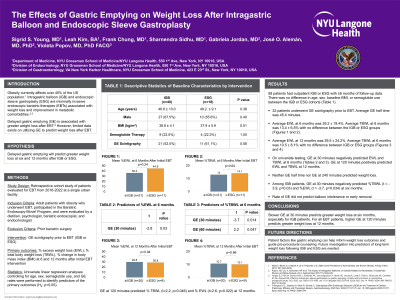Tuesday Poster Session
Category: Obesity
P4034 - The Effects of Gastric Emptying on Weight Loss After Intragastric Balloon and Endoscopic Sleeve Gastroplasty
Tuesday, October 24, 2023
10:30 AM - 4:00 PM PT
Location: Exhibit Hall

Has Audio

Sigrid Young, MD
NYU Langone Health
New York, NY
Presenting Author(s)
Sigrid Young, MD, Leah Kim, BA, Frank Chung, MD, Sharnendra Sidhu, MD, Gabriela Jordan, MD, Jose Aleman, MD, PhD, Violeta Popov, MD, PhD, FACG
NYU Langone Health, New York, NY
Introduction: Intragastric balloon (IGB) and endoscopic sleeve gastroplasty (ESG) are endoscopic bariatric therapies (EBTs) associated with weight loss and improvement in metabolic comorbidities. Delayed gastric emptying (GE) has been associated with greater weight loss after EBT. However, data utilizing GE to predict weight loss after EBT is limited.
Methods: Retrospective chart review was conducted on patients evaluated for EBT from 2016-2022 at a single urban facility. Patients with prior bariatric surgery were excluded. All patients participated in a weight loss program with a dietitian, psychologist, and bariatric endoscopist. Univariate linear regression analyses controlling for age, sex, semaglutide use, and GE rates were performed to identify predictors of % body mass index (BMI) change, % total body weight loss (TBWL) and % excess weight loss (EWL) at 6, 12, and 24 months after EBT (Ha: p< 0.05).
Results: Fifty-eight patients underwent outpatient IGB or ESG and had at least 24 months of follow-up data (IGB, n=40; ESG, n=18). Average BMI at T0 was 38.5±4.7 kg/m2 with no difference in age, sex, or baseline BMI between the IGB and ESG cohorts. 23% of patients were trialed on semaglutide.
Thirty-two patients (IGB, n=21; ESG, n=11) underwent GE scintigraphy prior to EBT. On univariate testing, GE at 30 minutes negatively predicted %TBWL (t= -3.7, p=0.014) and %EWL (t= -2.8, p=0.038) at six months. GE at 60 minutes positively predicted % TBWL (t=2.2, p=0.047) at six months, and GE at 120 minutes positively predicted %TBWL (t=2.2, p=0.046) and %EWL (t=2.6, p=0.022) at 12 months. Neither GE half time nor GE at 240 minutes predicted weight loss outcomes at 6 or 12 months. GE rates also did not predict weight loss at 24 months.
In a subgroup analysis of IGB patients, GE at 30 minutes negatively predicted % TBWL (t= -3.9, p=0.03) and % EWL (t= -3.7, p=0.034) at six months. Rate of GE did not predict balloon intolerance or early removal. Among ESG patients, GE at 120 minutes positively predicted % BMI change at six months (t=2.9, p=0.043), and GE at 240 minutes positively predicted both % BMI change at 6 months (t=8.2, p=0.004) and 12 months (t=109.2, p=0.006).
Discussion: For all EBT patients, faster GE at 120 minutes predicted greater weight loss at 12 months. Interestingly, slower GE at 30 minutes was associated with greater weight loss at six months for IGB patients, but not with weight loss at 12 or 24 months. These patient factors can inform weight loss outcomes and guide pre-procedural counseling.
Disclosures:
Sigrid Young, MD, Leah Kim, BA, Frank Chung, MD, Sharnendra Sidhu, MD, Gabriela Jordan, MD, Jose Aleman, MD, PhD, Violeta Popov, MD, PhD, FACG. P4034 - The Effects of Gastric Emptying on Weight Loss After Intragastric Balloon and Endoscopic Sleeve Gastroplasty, ACG 2023 Annual Scientific Meeting Abstracts. Vancouver, BC, Canada: American College of Gastroenterology.
NYU Langone Health, New York, NY
Introduction: Intragastric balloon (IGB) and endoscopic sleeve gastroplasty (ESG) are endoscopic bariatric therapies (EBTs) associated with weight loss and improvement in metabolic comorbidities. Delayed gastric emptying (GE) has been associated with greater weight loss after EBT. However, data utilizing GE to predict weight loss after EBT is limited.
Methods: Retrospective chart review was conducted on patients evaluated for EBT from 2016-2022 at a single urban facility. Patients with prior bariatric surgery were excluded. All patients participated in a weight loss program with a dietitian, psychologist, and bariatric endoscopist. Univariate linear regression analyses controlling for age, sex, semaglutide use, and GE rates were performed to identify predictors of % body mass index (BMI) change, % total body weight loss (TBWL) and % excess weight loss (EWL) at 6, 12, and 24 months after EBT (Ha: p< 0.05).
Results: Fifty-eight patients underwent outpatient IGB or ESG and had at least 24 months of follow-up data (IGB, n=40; ESG, n=18). Average BMI at T0 was 38.5±4.7 kg/m2 with no difference in age, sex, or baseline BMI between the IGB and ESG cohorts. 23% of patients were trialed on semaglutide.
Thirty-two patients (IGB, n=21; ESG, n=11) underwent GE scintigraphy prior to EBT. On univariate testing, GE at 30 minutes negatively predicted %TBWL (t= -3.7, p=0.014) and %EWL (t= -2.8, p=0.038) at six months. GE at 60 minutes positively predicted % TBWL (t=2.2, p=0.047) at six months, and GE at 120 minutes positively predicted %TBWL (t=2.2, p=0.046) and %EWL (t=2.6, p=0.022) at 12 months. Neither GE half time nor GE at 240 minutes predicted weight loss outcomes at 6 or 12 months. GE rates also did not predict weight loss at 24 months.
In a subgroup analysis of IGB patients, GE at 30 minutes negatively predicted % TBWL (t= -3.9, p=0.03) and % EWL (t= -3.7, p=0.034) at six months. Rate of GE did not predict balloon intolerance or early removal. Among ESG patients, GE at 120 minutes positively predicted % BMI change at six months (t=2.9, p=0.043), and GE at 240 minutes positively predicted both % BMI change at 6 months (t=8.2, p=0.004) and 12 months (t=109.2, p=0.006).
Discussion: For all EBT patients, faster GE at 120 minutes predicted greater weight loss at 12 months. Interestingly, slower GE at 30 minutes was associated with greater weight loss at six months for IGB patients, but not with weight loss at 12 or 24 months. These patient factors can inform weight loss outcomes and guide pre-procedural counseling.
Disclosures:
Sigrid Young indicated no relevant financial relationships.
Leah Kim indicated no relevant financial relationships.
Frank Chung indicated no relevant financial relationships.
Sharnendra Sidhu indicated no relevant financial relationships.
Gabriela Jordan indicated no relevant financial relationships.
Jose Aleman: Novo Nordisk – Consultant.
Violeta Popov indicated no relevant financial relationships.
Sigrid Young, MD, Leah Kim, BA, Frank Chung, MD, Sharnendra Sidhu, MD, Gabriela Jordan, MD, Jose Aleman, MD, PhD, Violeta Popov, MD, PhD, FACG. P4034 - The Effects of Gastric Emptying on Weight Loss After Intragastric Balloon and Endoscopic Sleeve Gastroplasty, ACG 2023 Annual Scientific Meeting Abstracts. Vancouver, BC, Canada: American College of Gastroenterology.
